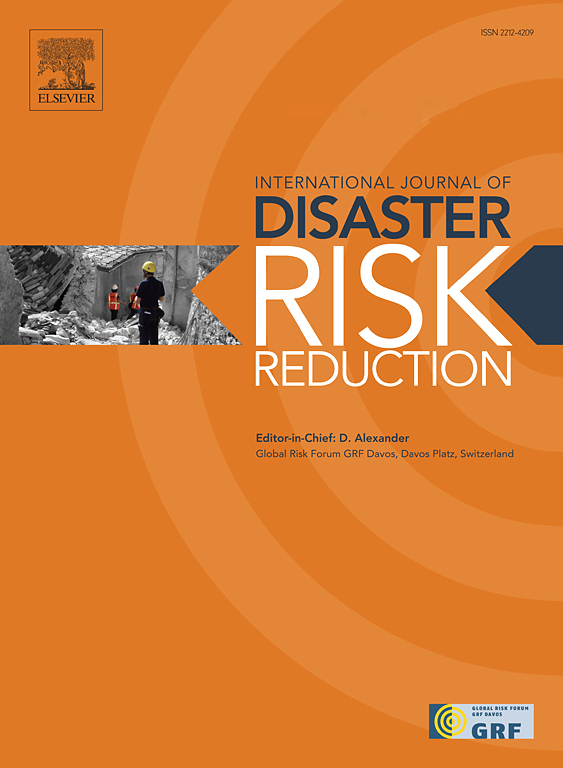Integration of effective antecedent rainfall to improve the performance of rainfall thresholds for landslide early warning in Wanzhou District, China
IF 4.2
1区 地球科学
Q1 GEOSCIENCES, MULTIDISCIPLINARY
International journal of disaster risk reduction
Pub Date : 2025-02-16
DOI:10.1016/j.ijdrr.2025.105317
引用次数: 0
Abstract
Empirical rainfall thresholds are widely utilized in landslide early warning systems (LEWS) at different scales. However, the approach ignores complex hydrological processes that predispose slopes to instability, leading to a relatively lower performance with high false alarm rates. The objective of this study is to address this limitation by proposing an updated 3D rainfall threshold approach that combines an assessment of the peak rainfall intensity with the contribution of antecedent rainfall conditions. While the former is obtained with a traditional intensity–duration (I–D) threshold approach, the latter is based on a purposely developed effective antecedent rainfall index (EARI), representing the most proximate regional soil moisture condition related to landslides. Thus, thresholds evolved from lines in the 2D space to planes in the 3D space, which were customized for 11 alert zones in Wanzhou District, China. The results highlight that the participation of EARI operates a consistent decrease in false alarms (ranging from 3.5 % to 94.8 % compared to the I-D approach). Beyond that, the power exponent decay EARI is more reliable than a simple sum-based antecedent rainfall in correctly identifying landslide conditions, resulting in higher performances up to 52.3 % if an operational application is simulated. The updated 3D threshold can be considered a good prototype for developing a LEWS because it evaluates both triggering rainfall and antecedent hydrological conditions with good performance and robustness. The general framework of the model could also be exported to other places, given the relatively simple structure and the wide availability of the input data needed.

不同规模的滑坡预警系统(LEWS)广泛采用经验降雨阈值。然而,这种方法忽略了导致斜坡失稳的复杂水文过程,导致性能相对较低,误报率较高。本研究的目的是通过提出一种最新的三维降雨阈值方法来解决这一局限性,该方法结合了峰值降雨强度评估和前降雨条件的贡献。前者采用传统的强度-持续时间(I-D)阈值方法,后者则基于特意开发的有效前降雨指数(EARI),代表与滑坡相关的最接近的区域土壤湿度条件。因此,阈值从二维空间中的线演变为三维空间中的平面,并针对中国万州区的 11 个警戒区进行了定制。结果表明,与 I-D 方法相比,EARI 的参与可持续降低误报率(从 3.5% 到 94.8%)。此外,在正确识别滑坡情况方面,EARI 的功率指数衰减比简单的前兆降雨量总和更可靠,如果模拟实际应用,其性能可高达 52.3%。更新后的三维阈值可被视为开发 LEWS 的良好原型,因为它既能评估触发降雨,又能评估前兆水文条件,具有良好的性能和鲁棒性。由于该模型结构相对简单,所需的输入数据来源广泛,因此其总体框架也可以输出到其他地方。
本文章由计算机程序翻译,如有差异,请以英文原文为准。
求助全文
约1分钟内获得全文
求助全文
来源期刊

International journal of disaster risk reduction
GEOSCIENCES, MULTIDISCIPLINARYMETEOROLOGY-METEOROLOGY & ATMOSPHERIC SCIENCES
CiteScore
8.70
自引率
18.00%
发文量
688
审稿时长
79 days
期刊介绍:
The International Journal of Disaster Risk Reduction (IJDRR) is the journal for researchers, policymakers and practitioners across diverse disciplines: earth sciences and their implications; environmental sciences; engineering; urban studies; geography; and the social sciences. IJDRR publishes fundamental and applied research, critical reviews, policy papers and case studies with a particular focus on multi-disciplinary research that aims to reduce the impact of natural, technological, social and intentional disasters. IJDRR stimulates exchange of ideas and knowledge transfer on disaster research, mitigation, adaptation, prevention and risk reduction at all geographical scales: local, national and international.
Key topics:-
-multifaceted disaster and cascading disasters
-the development of disaster risk reduction strategies and techniques
-discussion and development of effective warning and educational systems for risk management at all levels
-disasters associated with climate change
-vulnerability analysis and vulnerability trends
-emerging risks
-resilience against disasters.
The journal particularly encourages papers that approach risk from a multi-disciplinary perspective.
 求助内容:
求助内容: 应助结果提醒方式:
应助结果提醒方式:


